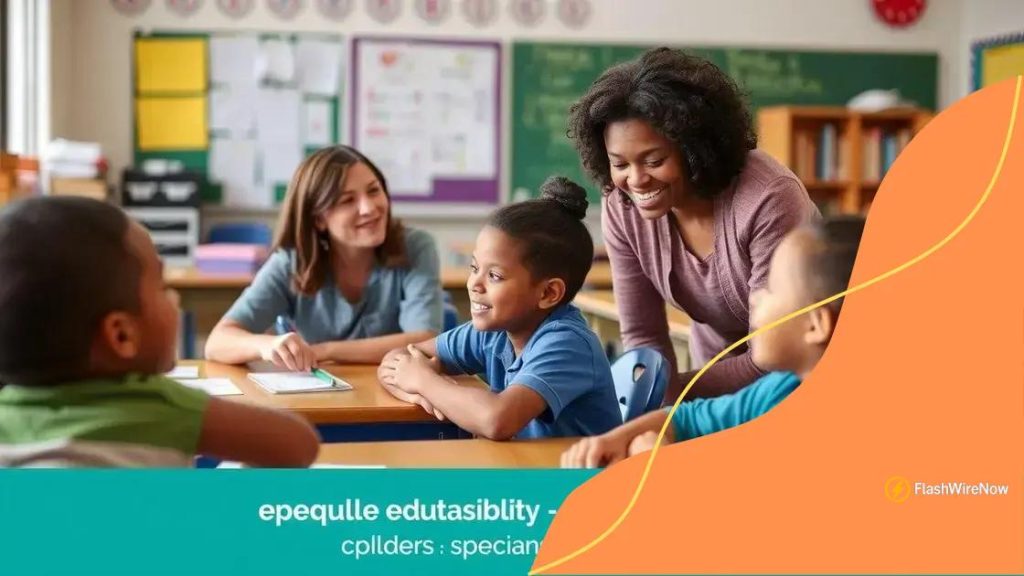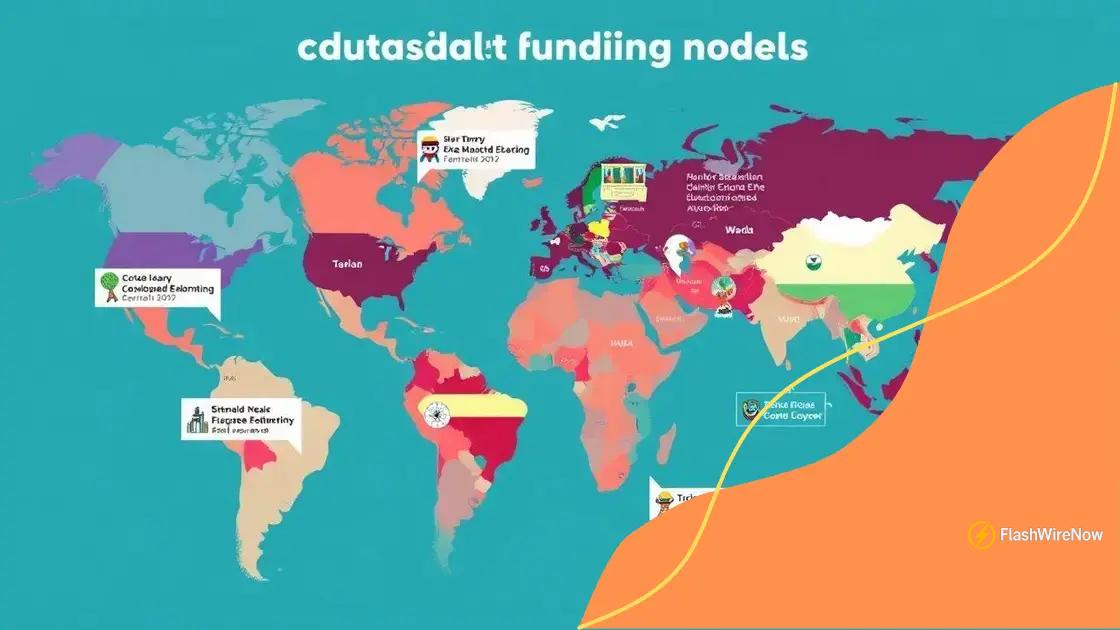Addressing the special education funding gap: a critical need

Anúncios
Addressing the special education funding gap involves advocating for equitable funding, learning from successful international models, and promoting community involvement to ensure all students with disabilities receive necessary resources and support.
Addressing the special education funding gap is essential for creating a fair educational landscape. Have you ever stopped to think about how unequal funding might affect students’ learning experiences? In this article, we’ll dive into the implications of this gap and explore potential solutions.
Anúncios
Understanding the special education funding gap
Understanding the special education funding gap is essential for grasping how it impacts students’ lives. Many schools struggle to provide adequate resources due to insufficient funding, leaving students with special needs at a disadvantage.
This gap can affect everything from teacher training to classroom materials. Ensuring that all students receive the support they need is critical.
Key Factors Contributing to the Funding Gap
Several factors play a role in the funding gap for special education. Here are some of the most significant:
Anúncios
- Inadequate state funding allocations.
- Variability in local tax revenues.
- Lack of awareness among policy makers.
- High costs associated with special education resources.
Certain regions may face larger challenges than others. For instance, rural areas often have fewer resources compared to urban schools. This discrepancy leads to inequalities in educational opportunities.
Impact on Special Education Programs
The gap in funding affects not only students but also teachers and staff who strive to provide a quality education. Without sufficient funding, teachers may lack access to training and resources needed to tailor their lessons.
This can result in inadequate support for students who require specialized attention. When classrooms are overcrowded and resources are stretched thin, the quality of education suffers.
For families, the impact can be profound, as parents may need to seek additional tutoring or support outside of the school system. In some cases, this leads to increased financial strain.
Ultimately, addressing the special education funding gap involves a collective effort from communities, policymakers, and educational institutions. By advocating for better funding solutions, we can help ensure that all students have a chance to succeed.
Impact on students and families
The impact of the special education funding gap is felt deeply by both students and their families. Without adequate funding, schools struggle to provide the necessary services and resources that students with special needs require.
This lack of support can lead to decreased educational outcomes, which in turn affects students’ self-esteem and overall well-being. Children who cannot access appropriate learning tools may experience frustration and disengagement from school.
Effects on Students
Students may face significant challenges when funding is insufficient:
- Limited access to specialized teachers or support staff.
- Inadequate resources, such as adaptive technology or learning materials.
- Higher student-to-teacher ratios, reducing personalized attention.
- Increased difficulty in meeting individual learning needs.
These challenges affect not only academic performance but also social interactions. Students may feel isolated, which can hinder their social skills and emotional development.
Effects on Families
The gap in funding also heavily impacts families. Parents may need to find additional resources outside of school to support their child’s education. This includes:
- Hiring private tutors or specialists.
- Utilizing community services for additional educational support.
- Spending extra time advocating for their child’s needs.
- Facing financial strain due to out-of-pocket expenses.
This pressure can lead to stress and anxiety for families who want the best for their children. Moreover, families may feel compelled to take action, advocating for better funding and resources, often becoming more involved in education policy.
Ultimately, the ripple effects of the funding gap highlight the need for renewed focus on equitably supporting all students. Ensuring every child has the right resources can make a transformative difference in their educational journey.
Successful funding models from around the world

Successful funding models from around the world provide valuable insights into how to address the special education funding gap. Different countries have implemented innovative solutions that ensure better resources and support for students with special needs.
For example, some countries focus on equity in funding distribution, ensuring that children everywhere receive the help they need. This approach creates a more inclusive environment in schools.
Key Examples of Successful Models
Here are some noteworthy funding models:
- Scandinavian Countries: Countries like Sweden and Norway allocate substantial funds specifically for special education. They prioritize individualized support for each student.
- Australia’s National Disability Insurance Scheme: This provides funding directly to families to help them access necessary services and resources for their children.
- New Zealand’s Inclusive Education: This model supports schools in creating tailored programs for students with diverse needs, focusing on community involvement.
- Canada’s Provincial Funding: Different provinces allocate budgets to ensure resources are available at local schools, allowing flexibility to meet specific needs.
These models show that investment in special education is crucial for student success. By implementing specific funding methods, countries can create an environment where all students thrive.
Furthermore, examining these successful models can help other nations adapt similar strategies. As parents, educators, and policymakers look for solutions, sharing these practices can inspire change.
Investing in the right resources fosters improved education outcomes for students with special needs. When schools can offer tailored support, everyone benefits.
Advocacy strategies for change
Advocacy strategies for change play a crucial role in addressing the special education funding gap. By empowering communities and individuals, these strategies can help bring awareness to the needs of students with disabilities and promote equitable resources.
Many effective advocacy strategies exist that can lead to positive changes in policies and funding.
Key Advocacy Strategies
Here are several key strategies that advocates can use to make a difference:
- Building coalitions: Uniting parents, educators, and community members can amplify the voice for special education needs. Collaborating with various stakeholders helps create a more powerful message.
- Engaging with policymakers: Regular communication with local and state officials ensures that the needs of students are prioritized. Advocates can share personal stories and data to emphasize their points.
- Raising awareness: Campaigns that educate the community about the importance of special education funding can gather public support. Social media, blogs, and community events are excellent tools for spreading the message.
- Providing training and resources: Equipping families and educators with the tools they need to advocate effectively can empower them to take action. Workshops and informational sessions can foster grassroots movements.
As advocates work to implement these strategies, they must continuously assess their effectiveness. Monitoring the outcomes of advocacy efforts allows for adjustments to be made as needed, ensuring that momentum is maintained.
Another significant aspect is fostering relationships with local media. Media coverage can spotlight the issues, bringing them into the public eye and garnering further support.
Advocacy requires persistence and commitment. By staying dedicated to their mission, advocates can drive meaningful changes in special education policy and funding.
Future prospects for special education funding
The future prospects for special education funding hold both challenges and opportunities. As awareness grows about the funding gap, many advocates are pushing for comprehensive reforms that could lead to better support for students with disabilities.
Policy changes at federal and state levels could reshape the landscape of special education. Increased funding allocations would ensure schools can meet the needs of every student.
Potential Developments in Funding
Some key developments that may impact the future of special education funding include:
- Policy Reform: Advocates are pushing for laws that prioritize equitable funding across districts, ensuring that all students have access to necessary resources.
- Increased Federal Support: The implementation of federal programs that provide additional financial support can help bridge the funding gap.
- Community Engagement: Engaging local communities in discussions about funding needs can lead to grassroots movements that promote change and attract donations or local funding initiatives.
- Technological Innovation: Advances in educational technology can enhance learning experiences, potentially reducing costs while maximizing resource use.
Many stakeholders believe that a coordinated effort can lead to real change. Teachers, parents, and policymakers must unite to advocate for better funding policies. By sharing success stories and data, they can illustrate the impact of adequate funding on student outcomes.
Furthermore, future funding models may adopt a more flexible approach, allowing schools to allocate resources according to specific local needs. Such adaptability can make a significant difference in student experiences and educational achievements.
Ultimately, the ongoing conversations and actions surrounding special education funding will determine how well students with disabilities can thrive in schools. It is crucial to stay informed and actively participate in discussions about these important issues.
In conclusion, addressing the special education funding gap is crucial for ensuring all students have access to quality education. By exploring successful funding models and advocating for necessary changes, we can work towards a more equitable system. The collaboration of educators, families, and policymakers is essential to drive this change. Together, we can create a future where every child has the resources they need to succeed.
FAQ – Frequently Asked Questions About Special Education Funding
What is the special education funding gap?
The special education funding gap refers to the difference between needed resources for students with disabilities and what is actually allocated by schools.
How can advocacy help improve funding for special education?
Advocacy raises awareness and influences policymakers to prioritize funding and resources for special education.
Are there successful funding models from other countries?
Yes, countries like Australia and Sweden have implemented effective funding models that prioritize equitable support for special education.
What can families do to support special education funding changes?
Families can engage in community advocacy, join coalitions, and communicate with local policymakers to promote necessary funding reforms.





